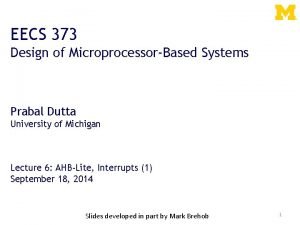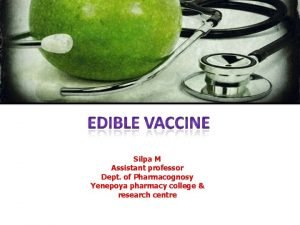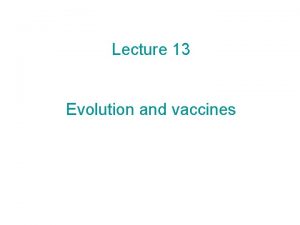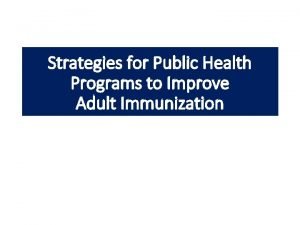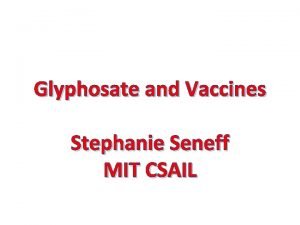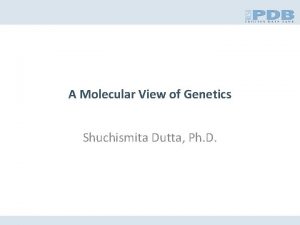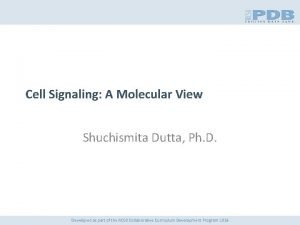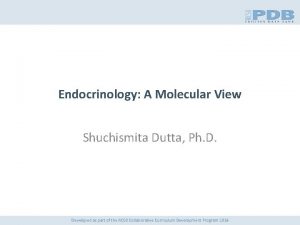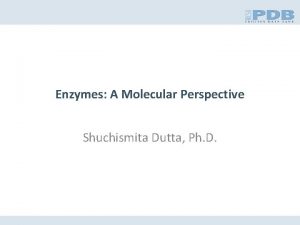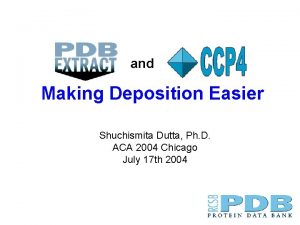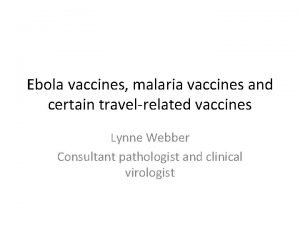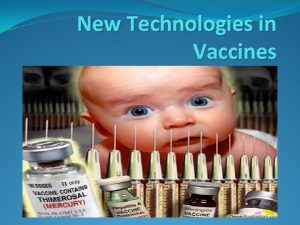Vaccines A Molecular View Associate Professor Shuchismita Dutta













- Slides: 13

Vaccines: A Molecular View Associate Professor Shuchismita Dutta, Ph. D. Assistant Research Professor, Dept. of Pediatrics, Chemistry and Chemical Biology RWJ Med. School Science Education Development The Child Health Institute of NJ Lead, RCSB PDB Rutgers University Lisa Denzin, Ph. D.

Learning Objectives • • • About Vaccines How do Vaccines Work? Types of Vaccines Herd Immunity The Annual Flu Vaccine • • • About Influenza Virus Influenza Types Influenza Antigens Types of Influenza Virus What is in the Flu vaccine? • Summary http: //www. smithsonianmag. com/sciencenature/vaccine-week-a-brief-history-and-howvaccines-work-18814542/? no-ist

About Vaccine • What is it? • Preparations of pathogen or parts of them • Induces immune system to respond to it (as if it is the real pathogen) and generate memory T- and B-cells • What does it do? • Prepares the immune system to recognize and destroy a pathogen when exposed to it. • Why is it important? • Vaccines protect individuals (and communities) from a large number of infectious pathogens by enabling them to rapidly mount a protective immune response upon encounter.

How do Vaccines Work? • Vaccines are taken up by macrophages (MF)/dendritic cells which activate the adaptive immune response • T-cells are activated • B-cells are activated • Antibodies are produced • Memory T- and B-cells are formed • Host is now prepared to mount immune response and protect the individual upon exposure to pathogen http: //www. nature. com/nri/journal/v 10/n 11/images/nri 2868 -f 1. jpg

Types of Vaccines Vaccine Type What is it? Challenges Examples Live Attenuated Weakened version of living microbe that can’t cause disease Mutation; Storage Measles, mumps, rubella, polio (Sabin vaccine), yellow fever Inactivated or “killed” Microbes killed with chemicals, heat or radiation Weaker immune response; Need boosters Cholera, flu, hepatitis A, Japanese encephalitis, plague, polio (Salk vaccine), rabies Subunit Include antigens (or epitopes) that best stimulate immune system Identifying specific antigen takes time Hepatitis B, pertussis, pneumonia caused by S. Pneumoniae Toxoid Formalin inactivated toxins used as vaccine Used when main cause of illness is a bacterial toxin Diphtheria, Tetanus Conjugate Specialized subunit vaccine where antigens are linked to polysaccharides Most effective for immature immune system of infants H. Influenzae type b, pneumonia caused by S. Pneumoniae DNA of important Antigens introduced to cell Experimental influenza and herpes as well as HIV Recombinant vector attenuated virus or bacterium (vector) used to introduce microbial DNA to cells Experimental HIV, rabies, and measles http: //www. niaid. nih. gov/topics/vaccines/documents/undvacc. pdf http: //www. vaccines. gov/more_info/types/

Herd Immunity • What is it? – Immunized majority allows few unimmunized in community (due to immature/compromised immune systems) to be protected from disease • Protection requirements – Required percentage of immunized individuals depends on R 0 (how many people 1 sick individual can infect in an unimmunized population) – Higher percentages of immunized individuals could stop the infection completely http: //cid. oxfordjournals. org/content/52/7/911/F 1. expansion. html

The Annual INFLUENZA Vaccine About Influenza HA and NA What is in the Flu Vaccine?

About Influenza Virus Life cycle of influenza virus and targets for therapeutic intervention Schematic diagram of influenza A virus Nature Reviews Microbiology 6, 143 -155 (February 2008) Nature Reviews Drug Discovery 6, 967 -974 (December 2007)

The Main Influenza Antigens Hemagglutinin (HA) • Proteins on surface of Influenza virus • Binds to host cell surface receptors PDB entry 1 ruz (Gamblin et al. , 2004) Neuraminidase (NA) • Enzyme - clips off polysaccharide chains from host cell surface • Facilitates new viral particle release PDB entry 1 nn 2 (Vargheese and Coleman. , 1991)

Types of Influenza Virus • Types A and B (related to seasonal epidemics); Type C (mild symptoms) • Influenza A – subtypes (H#N#) – Based on viral surface proteins • hemagglutinin (H) Types H 1 -H 18 • neuraminidase (N) Type N 1 -N 11 – Different strains seen • Influenza B – no types – Lineages • Yamagata • Victoria – Different strains may be seen • CDC follows internationally accepted naming convention for influenza viruses – Type/Geog. Origin/strain #/Year isolated (H#N#) e. g. A/Perth/16/2009 (H 3 N 2) for a virus from human origin http: //www. cdc. gov/flu/about/viruses/types. htm

Why Do the HA Numbers Matter? RBS H 6, PDB entry 4 wst H 5 structure showing RBS – Receptor Binding site and Fusion peptide Velkov et al. , 2013, Molecular Immunology H 10, PDB entry 4 wsx Yang et al. , 2015, Journal of Virology

What is in the Flu Vaccine? Nasal Spray Flu Vaccine Intradermal Flu Shot • Live Attenuated Vaccine • Usually protects against 2 influenza A and 2 influenza B viruses • Inactivated virus Vaccine • Traditional flu shots are “trivalent” – i. e. protects against 2 influenza A and 1 influenza B virus • Also available Quadrivalent flu vaccine – protects against 2 influenza A and 2 influenza B virus Also available as shots: • A high-dose trivalent shot, • A trivalent shot containing virus grown in cell culture • A recombinant trivalent shot that is egg-free. • Other vaccines in development http: //www. cdc. gov/flu/protect/keyfacts. htm

Summary • Vaccines prepare individuals to mount a protective immune response against the real pathogen(s) • Various types of vaccines are available – in all cases the pathogens or parts of them are modified so that they do not cause infection but do generate an immune response • Herd Immunity provides protection to individuals who have immature or weak immune systems, and cannot be vaccinated • Due to the variations in the influenza antigens, the flu vaccine needs to be taken annually to prevent serious infection
 Promotion from assistant to associate professor
Promotion from assistant to associate professor Anup dutta hcl
Anup dutta hcl Partha dutta rpi
Partha dutta rpi Prabal dutta
Prabal dutta Niloy dutta uconn
Niloy dutta uconn Dipanwita dutta
Dipanwita dutta Chris keane wsu
Chris keane wsu Dr s k dutta
Dr s k dutta Edible vaccines in pharmacognosy
Edible vaccines in pharmacognosy Edible vaccine definition
Edible vaccine definition Edible vaccines pros and cons
Edible vaccines pros and cons Could vaccines breed viciousness
Could vaccines breed viciousness Www.cdc.gov/vaccines/schedules/index.html
Www.cdc.gov/vaccines/schedules/index.html Stephanie seneff mit vaccines
Stephanie seneff mit vaccines



